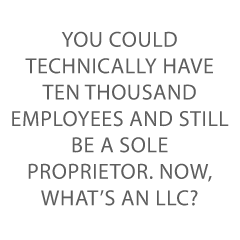Why is a Business Structure Important?
Eva threw her books on her dorm room bed. “Business structure? What the heck is a business structure? And why should it matter to me?”
Her roommate, Lisa, walked in, also tossing books – but onto her desk. “This is the weirdest assignment.” She scrunched up her face, her green eyes squinting for a moment.
“I hear ya. I mean, what does Professor Norris want us to do, anyway?” Eva tucked a strand of dark hair behind her ear.
“Something about the seminar we’re taking. Ever since everyone else dropped that class, I think he just wants to chat half the time, or something. He’s a nice enough teacher, but I think he’s a little disappointed it’s just us.” Lisa stared out the dorm room’s main window, overlooking the campus.
Day 1: Which Business Structure is Best?
 Eva fired up her laptop and pulled up the assignment on the screen. “It says, and I quote, ‘Because you are the only two students left in this class, you will be starting up businesses from scratch. The type of business does not matter. What does matter is how you approach this assignment.’”
Eva fired up her laptop and pulled up the assignment on the screen. “It says, and I quote, ‘Because you are the only two students left in this class, you will be starting up businesses from scratch. The type of business does not matter. What does matter is how you approach this assignment.’”
“Well, that’s as clear as mud,” Lisa said, “I wonder why he wants us to start with the business structure?”
“Search me. I guess we’ll find out tomorrow in class.” Eva clicked open her Spanish class assignment. “Gotta study. Verbs wait for no one.”
Day 2 Morning: Pick a Business Structure, any Business Structure?
Lisa and Eva walked into Professor Norris’s class, a room with just a desk and three chairs, and a whiteboard at the front. The professor, an older man with cliched patches on the elbows of his jacket, beckoned them in. “Ah, Ms. Danson and Ms. Ramirez! Do come in. What did you think of my little assignment?”
Eva put her backpack down and took a notebook and a pen out before storing the backpack under her seat as Lisa did the same. Eva said, “I’m not so sure I understand it.”
“Oh, Ms. Ramirez?”
“Well, it just seems like, shouldn’t we be worrying about the company name first? Or what we’re going to do? You know, something like that.”
“In real life, that would be true,” he said. “But here in Business Financing and Planning, we’ll do things a little differently. After all, you’re not really looking to get rich, but to learn. Or at least, if you do get rich from your coursework, please remember the little people.”
So, Why Does it Matter?
Lisa smiled at that. “I’m with Eva. And I’m not even so sure what this, this structure is supposed to be, anyway. I read the book, but it talked a lot more about who gets to be a vice president. And I’m thinking that’s a little premature right now.”
“Exactly,” said Eva. “I get the feeling you weren’t looking for us to start hiring or anything.”
“Of course not. Here, let me use the board for a moment, for a business structure example or two.” The professor got up and pulled a marker from a desk drawer. He drew a rectangle on the board and divided it into quarters. He labeled the quarters: Sole Proprietorship, C Corporation, S Corporation, and LLC.
Then, outside the rectangle, he listed: Legal Liability, Costs and Shares, and Taxes. “Each of these four options will make a difference when it comes to these three basic areas. But let’s start with some definitions.”
Two Quick Business Structure Definitions: Sole Proprietorships and LLCs
 The professor asked, “What’s a sole proprietorship, Ms. Danson?”
The professor asked, “What’s a sole proprietorship, Ms. Danson?”
Lisa said, “Isn’t that what people are when they do a side gig? You know, someone is a secretary by day, but by night they knit scarves and sell them online.”
“It can be,” said the professor. “But they don’t have to be. What do you think?” he turned to Eva.
“I guess you’re all by yourself. After that, I’m not sure.”
“Do either of you think that you can have employees if your business is a sole proprietorship?”
“Wouldn’t that be impossible?” asked Lisa.
“No, wait a second,” said Eva. “This is just the one owner. But the title doesn’t say anything about employees.”
“Exactly,” said the professor. “You could technically have ten thousand employees and still be a sole proprietor. Now, what’s an LLC?”
“Long live corporations?” Lisa cracked a smile.
“Not exactly, I bet,” said Eva. “But the ‘C’ does stand for corporation, right?”
“It does. The other two words are ‘limited liability’.”
“Well, that’s gotta be good,” said Lisa. “Who wants to go to jail or pay a fine if they don’t have to?”
“Read up on that,” said the professor. He glanced at his watch. “Time flies. Why don’t you both read up on all four and then make your choices this week, okay?”
Day 2 Afternoon: Wow, There Really ARE Differences
Back at the dorm room, Eva gathered her books and papers. “I’ll be at the library if anyone’s asking.”
“Got it. See ya in a bit.” Once Eva was gone, Lisa used her phone. “Yeah, Chuck? She went to the library. C’mon over.”
Chuck arrived in a few minutes, a big guy on the school’s hockey team. “Can I take you out for a coffee, or something? It’s a little early for supper.”
“In a minute or so. I just remembered; I need to do an assignment for Norris.”
“How long is that gonna take?”
“Five minutes, tops. See, he told us there are four ways to set up a company. And me and Eva are supposed to be pretending we’ve got startups. But I just have to pick one.”
“What are they?” After she told him, Chuck said, “So I gotta figure C Corporation is a typo. I mean, the word already starts with a ‘C’. Totally redundant. So that’s out.”
A Randomish Choice
“You got a funny way of deciding on things.” Lisa chewed a nail for a second. “What about S Corporation? What do you think that is?”
“Since I have no idea because this problem has nothing to do with engineering, I’ll call it a Steve Corporation. And believe me, you don’t want to go into business with my brother.”
Lisa chuckled. “I’ll keep that in mind if it ever comes up. I already think LLC is kinda weird. What do you think about sole proprietor? Norris said it means I would own everything.”
“So I’ll be dating a wealthy businesswoman? Count me in, Babe.”
“Sole proprietor it is.”
Day 2 Evening: Reasons
Eva took her stuff with her and shook her head as the librarians shooed the students out for the night. “Too many choices,” she muttered, and walked right into Chuck’s teammate, Tommy. Papers scattered everywhere. She bent down to pick them up. “Sorry!”
“That’s okay. You look like you got a lot on your mind. What’s so serious?” He knelt down to help her.
“It’s that seminar Lisa and I are taking. We’re supposed to be like businesspeople, and I have to choose a business structure. But I can’t decide.”
“Tell ya what. Let me take you to the coffee shop and I’ll get you a coffee and a muffin because you look like you missed dinner. And why don’t you tell me what’s what and bounce ideas off me, okay?”
“Are you asking me out, Tommy?”
He looked at her a little sheepishly. “Maybe…?”
“I’d love to. But I am kinda tired so please don’t be offended if my mind wanders.”
“Or you doze off!”
“Sorry in advance.”
Why Pick One or the Other?
They got their coffees and a muffin and sat down at the local coffee shop. A little soft jazz played in the background. “So tell me about this – it’s a business structure, right?” Tommy asked.
“Right. I’ve got a choice of four: sole proprietorship, C Corporation, S Corporation, and LLC.”
“What about a partnership?” He stirred sugar into his coffee.
“I guess it’s not on the table because I’m supposed to be the only owner.”
“Okay. So what’s the difference between, you called it a C Corporation and an S Corporation?” he asked.
What’s So Special About C Corporations?
She wiped her face with a napkin. “Really big businesses tend to be C Corporations. They have a completely independent life separate from their shareholders. So if you lose a shareholder due to leaving the company or selling shares, the company can go on as if nothing happened.”
“So this is big companies like Amazon?” He tasted his coffee.
“Probably. C corporations also have an advantage for raising capital because they can sell stock. The book also said they were better for higher risk businesses, too.”
“Why? What does risk have to do with it?” he asked as she took a bite out of her muffin.
She swallowed the bit of muffin and some coffee before answering. “It’s totally separate. So if the business gets sued, the owner isn’t liable beyond whatever they invested. But that can be gotten around, with what’s called ‘piercing the corporate veil’.” She made air quotes.
“Sounds fancy.”
“Ha–but it can really happen if the owner tells someone to commit fraud or a crime.” She pulled her muffin in two with her fingers.
“So don’t do that.”
“Very funny,” she said. “They also tend to be better if you think you might want to sell the business.”
Decisions by Committee
“Any downsides?” he asked.
“A C Corp is run by a board of directors.”
“So, a committee?” Tommy leaned forward.
“Kinda. And they can be paid for their troubles. But if you sell enough stock because you need to raise money, you can get into a bind.”
“By selling more than 100%, or something?” He stirred his coffee.
“Well, that would be fraud. I mean if you sell over half of it,” she said. “If you’re the owner and you own 49%, you no longer have a controlling interest. So if the other shareholders all get together, they can overrule you or even vote you out.”
“I got the perfect solution to that–just sell shares to people who don’t like each other.” He threw her a wicked grin for a second.
“Hmm, I wonder if that’s legal. The other problem is taxes. C Corporations pay state and federal taxes, sometimes also local taxes. This includes paying income taxes on profits.”
“So far it sounds reasonable. You want a refill?”
“Just a sec,” she said. “The problem is that a C Corporation can end up paying taxes twice.”
“Twice?” he turned pale.
“Yep, twice. First when it makes a profit, and the second time when dividends go to the shareholders. This happens even if there’s just one shareholder.”
“Wow, the IRS makes out like bandits with C Corporations.”
How About S Corporations?
He got them refills and sat down again. “They were outta muffins, sorry.”
“That’s okay.”
“You mentioned an S Corporation. How is that different from a C? Aside from the letter.” He blew on his coffee to cool it. “C Corps vs. S Corps—are they really that different?”
“It’s a special type of corporation. It avoids the double taxation you get with regular C Corps. So your profits and some of your losses can be passed through directly to the owners’ personal income. And regular, high corporate tax rates just plain don’t apply.”
“I bet the IRS wishes everybody with an S Corporation was really a C Corporation,” he said. “Actually, why are there any C Corps at all if an S is so much better?”
“Well, you can’t have more than a hundred shareholders.”
“Okay, so Amazon probably can’t do that. What about if the company gets sued? Do you still have the same protection like with a C Corp?”
“Hang on, I’ll check the book.” She fired up her laptop and navigated to the page. “Okay, hmm, it says here that the same liability goodness you get with a C Corp also happens with an S Corp.”
“Hey, you said people on the board of a C Corp can get paid. Is it the same for an S Corp?” he asked.
“You looking for a job at an S Corp, Tommy?”
“I don’t know.” He looked down for a second.
Reasonable Compensation
She peered at her laptop. “Okay, so you can still get paid if you’re on the board. But things get interesting if you’re on the board but also working for the company.”
“Like you would be in this assignment?”
“Yeah, exactly. It says here that this person needs to be paid what’s called ‘reasonable compensation’.”
“Better than minimum wage, I’d guess.” He nodded in the direction of the barista, who was playing with her phone.
“Definitely. And if they don’t get fair market value, the IRS could reclassify any added corporate earnings as wages.”
“I bet that would cost more.” He looked skeptically at his coffee. “Are there any other differences with taxes?”
“It says here that only the wages of any S Corp shareholder who’s also an employee are subject to employment tax. Any other income is paid to the owner as a distribution. Distributions are taxed at a lower rate, if at all.”
“Score one against the IRS.” He looked around. “I think we closed down the place. Ready to go?”
She chugged the last of her coffee. “Yeah. This was nice. I appreciate you listening to me babble about school stuff.”
“Maybe you can babble a little more tomorrow night,” he said.
“Why? What’s happening tomorrow night?”
“I’m taking you to dinner.”
Day 3 Morning: An Experiment
“Welcome back,” said Professor Norris as Lisa and Eva walked in. “Have either of you made any decisions on your business structure yet?”
“I’m going with a sole proprietorship,” said Lisa.
“And you, Ms. Ramirez?”
“I’m still not so sure. I’ve read more on C and S Corporations and I think I can decide between those two. But I don’t want to make a final decision until I’ve researched the others.”
“Fair enough,” said Professor Norris. “So, between the two of those, which would you pick?”
“An S Corporation, I think. You get the same liability protection with both. And you run both with a board of directors. And you also decide ownership with the percentage of shares someone owns,” said Eva.
“They sound identical,” said Lisa.
“They differ when it comes to taxes,” said Eva. “A C Corporation can be taxed double. But with an S Corporation, you can pass some of that through for owners. That way, the owner pays the taxes on their own personal income, and it’s at a lower rate.”
Role Playing
“Exactly,” said the professor. “Let’s conduct an experiment. Come with me to my desk.” He opened the top drawer and pulled out a small velvet bag. He fished a pair of oddly-shaped dice out of the bag. “You each get one.”
“Are these from a role playing game, or something?” asked Lisa.
“Yes, I played D&D back in the day. Your quest is to set up a business and choose the best business structure for it. Each of the dice has ten sides. You each roll one of the dice, one time.”
“Do we want a big number, or a small one?” asked Eva.
“You’ll find out,” he said.
Eva and Lisa rolled their dice. “I got a nine, is that good?” asked Lisa.
“That’s how many thousands of dollars you get to put into your business,” said the professor.
“I just got a four.” Eva sighed. “I don’t suppose you’ll let me roll again?”
“Yes, but not for this. Roll again, both of you.”
Telling the Future
 This time, Eva rolled a six and Lisa rolled a three. “What do the numbers mean now?” Lisa tossed her die in the air and caught it. “Do I get another three grand?”
This time, Eva rolled a six and Lisa rolled a three. “What do the numbers mean now?” Lisa tossed her die in the air and caught it. “Do I get another three grand?”
“Unfortunately, no. But these are magical dice – you can tell the future with them.”
Eva fought not to roll her eyes. “Excuse me?”
“We’re predicting what’s going to happen after a year in business. Odd number means your company is getting sued, sorry.”
“Do I at least have a good lawyer?” Lisa asked.
“Maybe you’ll need to spend some of your nine grand on one,” said Eva. “What about my even number?”
“IRS audit.”
Eva and Lisa looked at each other and, at almost the same moment said, “Trade ya.”
Day 3 Afternoon: If You Knew What Was Going to Happen, Which One Would You Pick?
Later, Lisa and Eva sat at their desks in their dorm room. “I think you’re right. I’d better save some of my money for a lawyer.” Lisa sighed.
“Good thing you’ve got it to spend. I have to figure out how to run my mythological business and also serve coffee and croissants to the IRS when they arrive.”
“Maybe the coffee shop can cater it. And look at you! Closing down the place, with Tommy Johnstone and everything.”
“He was really sweet. But I talked his ear off about our class.”
“Maybe he thinks words like ‘debenture’ are romantic, or something.” Lisa paused for a moment. “I think you should get your homework done beforehand. Otherwise, that’ll be the only thing you talk about.”
“Right, yeah.”
Can a Sole Proprietorship Work as a Business Structure?
Eva thought for a moment. “So, let me ask you. You picked a sole proprietorship. Can you tell me why?”
“Originally it was just a goof. But then I read up about it. If you’re a sole proprietor, you get to keep all the profits. It’s a 100% share, not like with any kind of a corporation where the percentage is diluted.”
“That’s good news. But if you’re making all the profits, do you pay all the taxes?”
“Yeah, that’s kind of a downside to it. But it’s simple at least. I think you can put everything on your 1040.” Lisa added, “Of course the IRS makes you fill out a million forms. But they do that anyway, I think.”
“Probably, so I guess that part’s a wash. I bet it’s really easy to set up, too.”
“Absolutely. There are places where you need to register any sort of business, but in others, you don’t. A sole proprietorship is kind of the path of least resistance,” said Lisa. “If you have a low risk business, it’s good, according to the book. And you can kind of use it as a starter before you get serious.”
“So it’s like having training wheels?” Eva’s eyes grew wider for a second.
Rethinking Sole Proprietorships and Other Things
“I guess.” Lisa scratched her head. “But now that I know a lawsuit is coming, I think I’d better rethink my business structure.”
“How come?”
“It’s that 100% ownership and 100% profits and 100% of the taxes–it also equals 100% of the liability.”
“So I guess your low risk business isn’t so low risk after all,” said Eva.
“I wonder if I can get some protection without having to do all the work to incorporate. I mean, you do realize that you need to file all sorts of stuff and designate someone to accept service of process and all that jazz?” asked Lisa.
“Yeah, that is a lot. But I think I might be okay for my tax audit. The profits split along the same line as ownership shares. I think the main thing I need to prove in my audit is that everything’s being split correctly. Oh, and that any owners who are working are getting a fair wage. Then the IRS will just see it all as a pass-through. I might not have to pay anything for my audit.”
“So you can afford coffee and croissants for them after all.”
Is an LLC the Way to Go?
Eva thought for a moment. “You know, when Professor Norris first gave us this assignment, he said the LL in LLC stands for ‘limited liability’. I bet that would come in handy in a lawsuit.”
“Oh, yeah!” Lisa started clicking on her laptop’s keyboard. “Hold the phone just a second. Here, here it is. It says that the owners of an LLC are called ‘members’, as opposed to corporation owners, which are called ‘shareholders’.”
“Er, okay. Go on.”
“So in an LLC, it seems members are protected from personal liability for business decisions or actions of the LLC.”
“That sounds promising,” said Eva. I wonder if maybe an LLC would be a better choice?
“No, wait a second. There’s always a cloud for every silver lining. It says here that if the LLC goes into debt or is sued, members’ personal assets are often exempt. But not always.”
“Hence the term ‘limited liability’, I bet,” said Eva.
“Still, it looks like it would be better,” said Lisa.
Lawsuits and the Legal Structure of a Business
“Maybe for a lawsuit, yes. But what about how the profits are divvied up?”
“So it says here that the IRS doesn’t consider an LLC to be a separate entity. So the IRS follows certain rules depending on the size of an LLC,” Lisa read off her screen.
“What kinds of rules?”
“It’s for when it comes to deciding whether to treat a business more like a partnership, or a corporation, or a sole proprietorship.”
“That seems like you could be a corporation without so much paperwork.” Eva picked up a pen. “Assuming you could get the IRS to agree with you on how to treat your LLC.”
“Right, yeah. It says here that the costs and shares for an LLC work like they do for corporations. So if you own 40%, then you get 40% of the profits.”
Tax Audits
“Well, that’s something,” said Eva. “How are LLCs different when it comes to taxes?”
“That’s a good question.” Lisa peered at her screen. “It says that since the IRS doesn’t see an LLC as a separate entity, it isn’t taxed directly. Instead, members pay individual taxes. Members have to pay an employment tax on the entire net income of the business.”
“Okay, that is definitely harder to deal with than a corporation when it comes to my tax audit.”
“Definitely.” Lisa read to herself for a while. “Oh, yeah, you don’t want this if you’re being audited.”
“Give me the bad news.” Eva put down the pen.
“There’s something extra to click on. The online book says it’s new, the pros and cons of LLCs. Hmm, let me see.”
Taxes
“You want to read that out loud, Lisa?”
“Hold your horses. Okay, it says LLCs don’t pay the double taxation of standard corporations. Also, if they ‘pass through’ profits to member tax returns, LLC owners may benefit.”
“In what way?”
“It says they may be able to deduct 20% of their business income with a 20% pass-through deduction that comes from the Tax Cuts and Jobs Act of 2017.” Lisa read off the screen.
“Hey, 20% is nothing to sneeze at.”
“Exactly. But it also says LLC members can end up paying employment taxes on the entire net income of the business.”
“Sounds like you lose out if the company does well. That’s messed up,” said Eva.
“Speaking of messed up, look at the time! You need to get ready for your hot date, my friend.”
Day 3 Evening: A Business Structure Decision
Dinner went well–Tommy complimented Eva’s outfit, pulled out her chair, and did about everything but kiss her hand.
“This has been great,” he said as they lingered over dessert. “You think we’ll close down this place, too?”
“Maybe. And thanks again for listening to me go on about school yesterday.”
“Any time. I noticed you said nothing about it tonight. Did you make a decision for your assignment?”
“I did, actually. But some of it was from Professor Norris kind of putting his thumb on the scale.”
“Oh?”
“He had us roll dice to decide how much money we’d have to start with, and a particular bad thing that would happen in a year to each of our businesses.”
“What sort of bad thing? Do aliens attack, or something?”
“No, silly. Lisa got a lawsuit and I got a tax audit.”
“Well, you know how I feel about the IRS. Did that help you make up your minds?” He took her hand.
“And how! Lisa picked an LLC because she could protect the owners without all the bother and expense of setting up a corporation.”
“I see. And you?” He looked into her eyes.
“S Corporation. Although I think a C Corporation would be okay, too, at least when it comes to taxes. But I do worry a bit about the setup costs and all. When the dice rolled, I didn’t get as much as she did.”
A Comparison
He put down his fork and pulled his phone from a breast pocket. “I get the feeling she might not be taking all the costs into consideration. Mind if I check my phone and run a down and dirty comparison?”
“Oh, it’s fine. But next time, don’t be checking your phone.”
“Next time?”
“Our next date. It’ll be my treat–I’ll take you to the movies,” she said.
“I swear I will even sit through a chick flick if you want me to.” He tapped on his phone. “Aha, I was right. Lisa might want to rethink that whole setup costs thing.”
“Tell me more.” She put her elbows on the table and cupped her chin in her hands.
“It’s $52 to file Articles of Incorporation for an S Corporation. And,” he paused, “wait for it, Articles of Organization for an LLC cost $104 to file. So it’s twice as much.”
“I wonder if that’s the same everywhere.”
He looked at his phone some more. “It depends. Some places, it’s cheaper the other way. And you can have both at the same time. I’m sure any given state will just take your money and not give you a discount for buying in bulk.” He put his phone away. “Now let’s talk about how beautiful your eyes are.”
Day 4 Morning: Results
“Did you stay with a sole proprietorship for your business structure, Ms. Danson?”
“No, I didn’t,” said Lisa. “Once you said I was going to be sued, it became obvious that I would need some protection. I picked an LLC. I figure it’s cheaper than setting up a corporation.”
“Sometimes,” said Professor Norris. “And you?”
“I went with an S Corporation. Taxes pass through, so the auditors wouldn’t really have much to talk about. And if I ended up on the, heh, business end of a lawsuit, I’d be okay then, too.”
“Excellent work, both of you. Now, which one is better for getting funding?”
“That wasn’t part of the assignment,” Lisa looked pale. “Er, was it?”
“It wasn’t,” said the professor.
“Does it matter?” asked Eva.
“It most certainly does. And you picked the better business structure.”
“I did?” Eva blinked in disbelief.
“Absolutely–because your business has to be its own separate entity for building what’s called business credit.”
“What’s that?” asked Lisa.
“A topic we’ll cover another day.”

